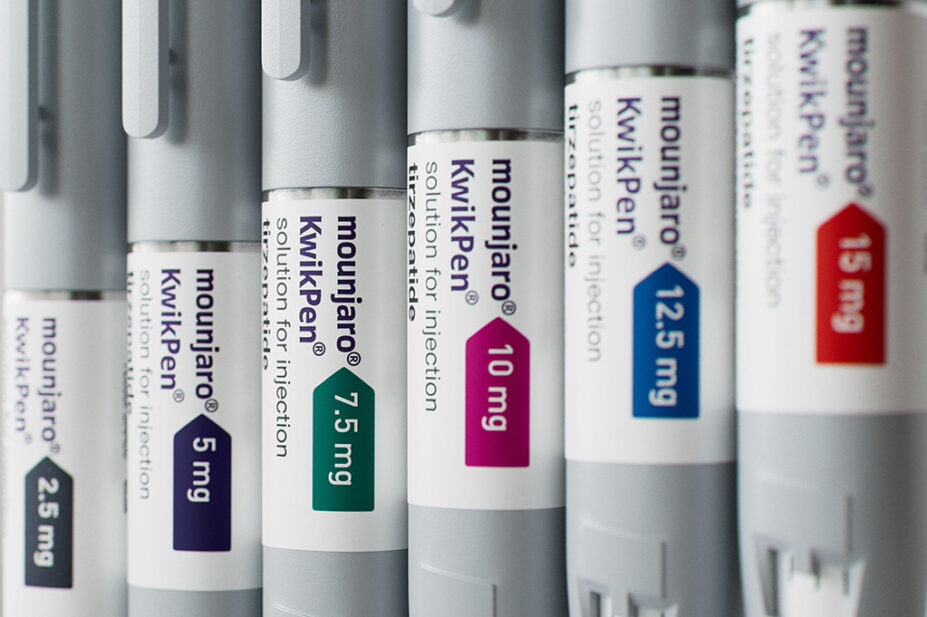
Allan Swart / Alamy Stock Photo
People who stop using the weight-loss drug Mounjaro (tirzepatide; Eli Lilly) can regain weight and experience reversal of other health benefits, a study has found.
Analysis of the SURMOUNT-4 trial, published in JAMA Internal Medicine on 24 November 2025, has revealed a higher degree of weight regain was associated with a greater reversal of improvements in waist circumference, blood pressure, non-high-density lipoprotein cholesterol, glycaemic parameter and insulin resistance one year after tirzepatide withdrawal.
The study used data from 308 participants who had been on tirzepatide treatment for 36 weeks. After this, participants were randomised 1:1 to continue treatment or switch to a placebo for a further 52 weeks.
Researchers assessed weight regain at week 88 — the final week of the trial — by calculating this as a percentage of weight lost while receiving tirzepatide from week 0 to week 36 and categorising this as ‘less than 25%’, ‘25% to less than 50%’, ‘50% to less than 75%’, and ‘75% or more’.
They found that, during the 36 weeks of treatment with tirzepatide, participants’ weight decreased and cardiometabolic parameters improved.
However, following withdrawal of tirzepatide from week 36 to week 88, 82% of participants regained at least 25% of their initial weight loss, with those regaining more experiencing a greater increase in waist circumference, as well as reversal of other health benefits.
Participants who regained less than 25% of their lost weight had an average change in waist circumference of 0.8cm and increases in systolic blood pressure of 6.8mmHg, HbA1c by 0.14%, and fasting insulin by -4.0%.
However, as weight regain increased, these measures worsened. Those regaining 50% to less than 75% of lost weight had an average waist increase of 10.1cm, while their systolic blood pressure rose by an average of 9.6mmHg, non-HDL cholesterol by 8.4%, HbA1c by 0.27% and fasting insulin by 46.2%.
At ≥75% regain, waist circumference rose an average of 14.7cm, blood pressure rose by 10.4mmHg, non-HDL cholesterol by 10.8%, HbA1c by 0.35% and fasting insulin by 26.3%.
“In this post-hoc analysis of the SURMOUNT-4 trial, among participants with obesity who achieved weight reduction with 36-week tirzepatide treatment, withdrawing tirzepatide led to 25% or greater weight regain in most participants within one year and was associated with a greater reversal of their initial cardiometabolic parameter improvements compared with those who maintained weight reduction,” the authors said.
They added that the findings “underscore the importance of continued obesity treatment”.
In response to the study, a spokesperson for Eli Lilly said: “Obesity is a chronic, progressive disease that often requires long-term treatment. Like other chronic conditions, therapy should continue when medically indicated to maintain benefits.
“Lifestyle changes alone — diet, exercise, and counselling — may not deliver sufficient and sustained weight loss for long-term health for every individual. Many individuals require varying degrees of medical support combined with tailored lifestyle modifications to successfully achieve and maintain their weight goals.
“Our post-hoc analysis of SURMOUNT-4 found that 82.5% of participants who stopped tirzepatide regained at least 25% of their lost weight within a year, which is consistent with other studies referenced in the paper. This weight gain was associated with reversal of improvements in blood pressure, cholesterol, blood glucose and insulin sensitivity, reinforcing the need for continued treatment in adults living with obesity.”
Details from phase III of Novo Nordisk’s EVOKE trial, announced on 24 November 2025, found that glucagon-like peptide-1 receptor semaglutide had no effect on the progression of cognitive decline in people with Alzheimer’s disease, despite previous hopes that it could slow the disease.

